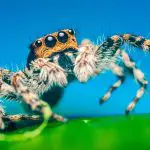Last updated on February 1st, 2023 at 10:06 am
Are Jumping Spiders dangerous? If you’re a little bug, then yes! For humans though there is nothing to fear. Read on to learn more…
If you’re curious about whether or not jumping spiders can harm you, read this article to learn more about the animal. As you’re about to find out, these spiders are harmless unless you have an allergic reaction to their bite, which is exceptionally rare.
Jumping spiders are extremely friendly and smart creatures. They use their webs to move from one place to another without getting building full ones like other spiders. They also use their acute eyesight to hunt small flies and pounce on them accurately – therefore providing pest controls for us humans.
Are jumping spider bites painful?
While jumping spiders can inject venom, the venom from their bites is usually mild, making them unlikely to cause any serious harm. Despite this, they may still bite you if you squeeze, trap, or crush them. If you suspect that you have been bitten by a jumping spider, don’t panic, the most likely result is some short term discomfort, but nothing that will last or do serious damage.
Jumping spiders can be a range of different colors and can be as large as 10 to 35 mm long. Despite being harmless, the bites of jumping spiders can be dangerous to those who are allergic to them. They can also cause a number of symptoms similar to those of a wasp sting, including a rash and localised redness.
Allergic reactions are extremely rare, but if you suspect one you should seek immediate medical attention.
Symptoms of an allergic reaction include:
- Hives
- swollen lips or face
- palpitations
- dizziness
- difficulty swallowing
- difficulty breathing

Are jumping spiders smart?
It’s been claimed that jumping spiders are the most intelligent of all spiders, which may be true. Spiders have brains that are roughly equivalent to a poppy seed, so it’s quite possible that they have more intelligence than we thought.
To find out for sure, you should see a jumping spider in the wild. Watching them move and hunt is fascinating, and will quickly show you just how cunning they are, almost like cats.
Portia jumping spiders are known to have the sharpest eyes, but their intelligence is not clear. It has been observed that these spiders have different strategies for hunting their prey which is almost exclusively other spiders.
One strategy involves mimicking the shake of a male Euryattus spider. Female Euryattus spiders build nests in dead leaves and suspend them in the air by silk. The male Euryattus then crawls down the silk suspension ropes and stands on top of the nest.
Once he reaches the nest, he signals to the female Euryattus to come out of the nest. Portia’s imitation is a way of luring her to an ambush. This clearly shows evidence of planning and abstract thinking, something you wouldn’t expect from an arachnid!

Are jumping spiders friendly?
Some people think that jumping spiders are friendly, but there it’s actually pretty hard to tell. They seem friendly, but they may in fact just be curious and unaggressive. In fact, they are often said to be curious about people.
While they are not particularly fond of human contact, they are friendly enough to crawl around on your hands once they no longer feel scared. However, unless you are confident handling spiders it is advised that you leave them be.
These creatures have eight legs and are furry with large, watery eyes that definitely make them look friendly. When approached, they will often turn to look at you rather than run away.

Where do jumping spiders live?
If you have ever wondered where do jumping spiders live, you’re not alone. This type of spider has eight eyes and can see 360 degrees, making it a truly fascinating creature.
They live in woodland areas and on walls and fences around human settlements. They are best spotted in places where there is light vegetation, like tree bark.
Jumping spiders are a diverse group, with hundreds of species found on all continents asides from Antarctica. In the US, Jumping Spiders occur in every state, but they are most diverse in the southeast where the climate is warm and humid.
These venomous spiders are not dangerous to humans, but they can bite and a little sting. As for their appearance, they’re usually a little bit smaller than their aggressive cousins. But beware! You may accidentally bring a jumping spider into your home.

Are jumping spiders good to have around the house?
While some people fear these tiny creatures, you shouldn’t worry. Jumping spiders are generally harmless. While they may jump on your shoes and clothing, they won’t bite unless you really provoke them.
In most cases, a jumping spider bite will cause only minor pain and swelling. They can also cause a small infection, but they are usually harmless. If you have them around the house, you may want to consider letting them stay…
The most common reason to keep a jumping spider in the house is for the free janitor service they provide by eating small bugs.
Because jumping spiders have excellent eyesight, they’re great for hunting. They’ll spool out a silk string to attach to a solid object, and then jump onto their prey to pounce.






